
Annoying as hell, isn’t it?
When a guy who launched his first blog a couple of months ago is already getting dozens of comments and hundreds of shares anytime he posts something new.
While over in your world, a comment from someone not related to you is still a huge win.
What’s he doing differently? In fact, what sets apart all those bloggers who can rapidly build an insanely engaged audience from those who have to beg and plead just to get a handful of shares?
Is the answer really just “great content?”
Content is important, but plenty of bloggers put just as much time, energy and care into their content as those in the top tier, only to experience 10% of the results.
So what do the big guys have that the little ones don’t?
They have a relationship with their audience.
Why (Only) Emailing Out Your Latest Post Shows a Serious Lack of Imagination
Blogs are a great way to get your ideas into the world, but they suck for building relationships.
That’s because a blog post doesn’t create a connection. It’s like a public announcement. Readers feel no more bonded to you than they would to a poster pinned to a noticeboard.
And while it’s true that you might interact with a few keen readers via your blog comments, the silent majority will feel like anonymous observers.
An email, on the other hand, is more personal.
Even though the average email broadcast is no more tailored to its recipients than a blog post (beyond the trivial “Dear First_Name” personalization), it has a totally different feel.
We all know the same message went to everyone, and yet it somehow still feels more personal when it’s in your inbox.
When you change the medium, you change the message.
And that’s why email is your best path to forming deep, lasting relationships with your blog audience.
If you can get your readers to engage with your emails, and even start to look forward to them, you’ll build relationships that will result in more shares, comments and traffic.
Unfortunately, most bloggers fall into a “set it and forget it” mentality with their email lists.
Their idea of relationship-building is sending an automatic “Here’s a link to my latest post” email every week until the end of time (sprinkled with the occasional “Hey, buy something from me” email, of course).
If you’re doing it this way too, it’s probably time to become more imaginative with your subscriber broadcasts.
But here’s the good news: It’s actually not that difficult to engage with your audience via email when you know the right types of emails to send.
Here are seven emails you can integrate into your routine to lift your open and click rates, increase reader engagement and develop long-lasting relationships.
#1: The “Unexpected Content Bomb” Email
All right, be honest for a moment . . .
You wax lyrical about the benefits of subscribing to your email list, but is there really anything special about being on it? What do you send your subscribers to make them feel more valued for having signed up?
Sure, you might shoot them a free resource for trusting you with their email, but is there any other exclusive benefit they get as a long-term member of your email list?
Until recently my answer to this question, like most other bloggers, was no—the only added benefit of staying on my email list was a friendly note whenever I want you to read my latest post.
Upon honest evaluation, I decided that wasn’t enough, so I decided to shake things up.
On a Wednesday night, I wrote a content-driven email exclusively for my email list subscribers. The focus was similar to my blog posts (which are about copywriting and marketing), but I adapted the content to a more conversational style better suited to email.
I started with a personal touch:
Greetings copywriting friends,
I was planning on sending you the first-ever Copygrad video this week, but my voice gave out (thanks, seasonal allergies).
Luckily, United Airlines’ new CEO just sent out an email FULL of teachable copywriting moments.
From there, I dove straight into the content—showing off laughably bad excerpts of the United Airlines email and extracting copywriting lessons from each one.
I wrapped it all up with another personal touch:
Before you go, I’m curious…what’s the worst email you’ve received lately? Hit “Reply” and tell me about it, or simply forward it to will@copygrad.com. We can point and laugh at it together and stuff.
Stay in touch,
Will
My admission at the beginning of the email was the truth; this truly was a last-minute backup plan—a “throwaway” effort of sorts. I didn’t expect much in return.
So the response I received after the email went out Thursday morning was nothing short of overwhelming.
I received 19 personal replies to the email, ranging from “Nice job” to an offer to hire me for a $4,500 consulting project.
Surprisingly, it even led to influencers sharing the email on social media:
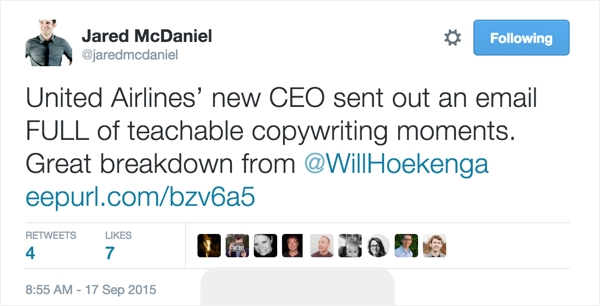
CAPTION: Jared McDaniel, co-founder of help desk software startup Help Scout, tweeted the archive link of the email (something I didn’t even realize you could do).
“But Will, you probably have a huge email list that responds no matter what you send,” you might say.
Wrong.
At the time I sent this, my email list was only 1,110 subscribers strong. Here’s proof:

You don’t need a big email list to reap the benefits of Unexpected Content Bombs. All you need is:
- A personal touch to kick off the email – Make sure your subscribers know they’re the only ones getting to read it.
- Valuable content – This should go without saying, but make sure the email helps them accomplish something. You should be sending more than just, “Hey, what’s up?!”
- A call to action to reply – Tell them to reply to the email. Ask a compelling question. Let them know you’re there to help. Not only will the responses advance your relationship with readers, they will also indicate to email clients that what you send doesn’t belong in the dreaded SPAM folder.
Don’t have the bandwidth to create exclusive email list content AND keep up your blogging schedule? I hear you. That’s why you might want to send…
#2: The “Whole Shebang” Email
I want to make it as easy for readers to consume my content as possible. ‘Clicks to my website’ don’t matter to me nearly as much as adding value and building trust with my readers.
That’s what Kevin Duncan of BeABetterBlogger.com said to me when I asked him about the way he communicates with his audience of 21,000+ via email.
So how does he add value and build trust with every email he sends? He gives away the whole shebang.
Rather than linking to the blog post in his email, he includes the entire post so subscribers can read it right in their inboxes.
Revolutionary? Not exactly—but too few bloggers consider the pros and cons of each approach before making a decision. They just send a link to their posts because that’s what everyone else seems to do.
While including an enticing preview and then linking to your blog post might result in more traffic to your website and social shares, Kevin sees things differently:
Emails like these add value. They build trust. Just think about how rare and uncommon it is to receive an email that asks nothing of you. Its sole purpose is to educate, inspire, and help you.
Isn’t that the type of mailing list you’ll tell others about? Isn’t it the kind of list that survives the occasional inbox purging when you get tired of all the emails you’re receiving? Isn’t it the kind of list whose owner you’ll tend to trust?
Judging by the responses Kevin got from a recent email, the answer to those questions is a resounding yes. Check out this collection of email responses from Kevin’s inbox:
When you send content-rich emails, rather than short emails that demand an action, something magical happens…
You train subscribers to read your emails, not just your blog posts.
You can see this in the responses from Kevin’s readers:
- “Your emails are always so funny and fun to read.”
- “I really enjoy reading your posts and emails.”
Again, if you don’t have the time to put together Unexpected Content Bombs (like example #1 showed), simply inserting your entire post into your email can be a good way to start training readers to read your emails.
That way, when the time comes for you to send them something other than a new blog post (like a product you’re selling), they’ll be eager to open the email simply because they want to read what you have to say.
#3: The “Useful Recycle” Email
Even if you’re new to blogging, you’ve probably heard the phrase “repurposed content” at least once.
The concept is simple and effective—take an existing piece of content you’ve already created and repurpose it into a different type of content so you can maximize its reach.
For example:
- Getting video content transcribed and turning the transcription into a written blog post
- Turning a written blog post into a podcast episode
- Turning a handful of related blog posts into an ebook or email course
Recently, however, I’ve seen a trend pop up in repurposed content that offers a tremendous amount of value to blog subscribers, with a relatively low amount of work for bloggers:
Re-releasing a popular piece of content in a new format.
There’s a subtle difference here—you’re not positioning the content as brand new. Instead, you’re giving your audience a new way to enjoy the content they already love, and you deliver it to them via email.
Popular blog WaitButWhy.com executed this to perfection in an email to its subscribers.
A few weeks after publishing a massive blog post about SpaceX, Elon Musk’s rocket company, Tim Urban, the author of the post, sent an email out to his blog subscribers giving them access to an audio version of the post, and a PDF version they could purchase for $3.
The email looked like this:
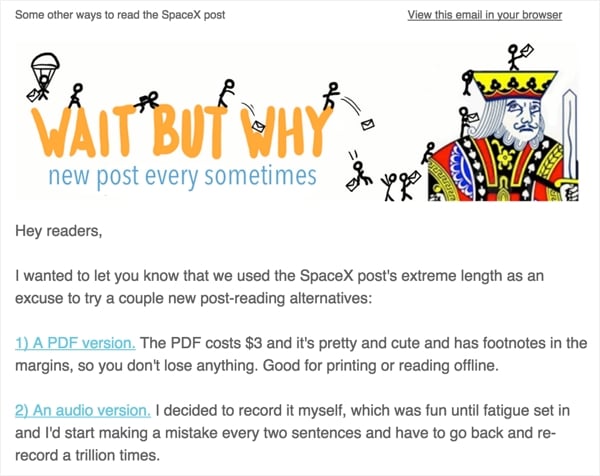
(Don’t be fooled by the homemade graphics, because Wait But Why has a following of hundreds of thousands of dedicated readers. The SpaceX post alone has over 41,000 shares to date.)
The response the audio version of the post received has been overwhelmingly positive. Take a look at a small selection of the many comments:
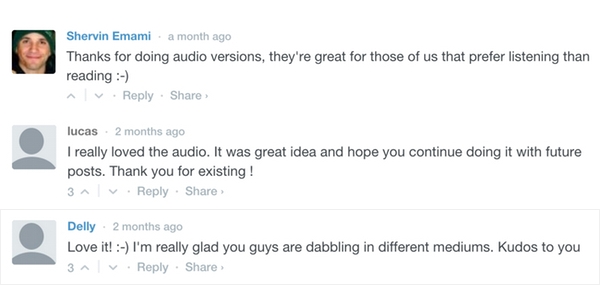
Love. Thanks. Kudos. Those are words you want to see in comments from your readers.
You may not have an audience of thousands, but if you have readers who enjoy your content, chances are some of them would love it in a different format.
Emailing an audio version of a recent well-received post is a great way to squeeze even more engagement out of something you already put in the hard work to create.
It’s less mental strain on you as a content creator and adds value and enjoyment for your readers.
#4: The “Free Consultation” Email
I have a few hundred subscribers sitting on my list, but I have no idea what to email them.
A friend who just began building an email list said that to me recently. He was trying to figure out what type of content to send his new subscribers but didn’t know what to do in the meantime.
So I suggested something that usually sounds a little “off” to most people—to send his subscribers an email offering a free consultation.
Now I get why some people don’t want to do this. They might think the following:
- “Consultations will consume a lot of my time.”
- “If I offer this for free right now, no one will want to pay me for it later.”
- “It’s scary—what if I get on the phone with someone and can’t deliver?”
However, you’re more likely to:
- Create real, lasting relationships with people on your email list.
- Build a great pool of references for case studies and testimonials.
- Develop a better understanding of your audience’s biggest pain points.
- Grow better at delivering value (because it keeps you on your toes).
And here’s the best part—you can limit the amount of free consultations you offer and still reap the majority of those benefits.
All you have to do is send the right email. Specifically, your email offering free consultations needs to do three things:
- Limit the number of calls offered and set expectations. Tell your subscribers how many openings you have available and how long each call will be. By setting limitations, you save yourself time and increase your list’s sense of urgency.
- Attach a clear, concrete outcome to the consultation. Don’t just tell your subscribers, “Hey, I’m doing free consultations, want one?” Outline the specific benefits they’ll get from the consultation and how it will be structured.
- Have them apply for the consultation. Rather than operating on a “first come, first served” basis, tell your subscribers to answer a handful of questions to be considered for a free consultation. This gives you the chance to gain valuable insight into your audience and pick and choose the people you most want to work with.
You’ll notice that asking your audience specific questions is a consistent theme in several of these emails. That’s because getting your readers to begin personal conversations with you in their inboxes is a surefire way to create real relationships. These email examples give you a variety of vehicles for delivering those questions and beginning those conversations.
Here’s an excerpt from the email I sent that shows exactly how I included those three elements:
I’m giving away five 30-minute, 1-on-1 copywriting and conversion consultations—100% on the house.
This will be a live Skype call consisting of you, me, and the web page that you think is most important to your business right now. During the call, I’ll show you:
- The clear, concrete steps you can take right now to start increasing your conversion rate on the page (more signups, more sales, etc.).
- Actual copy (written in advance by me specifically for your site) you can plug in and start using immediately.
- The repeatable framework I use whenever I want to increase my own (or my clients’) conversion rates.
Ready to reserve one of these five free consultations? Awesome! Hit “Reply” to this email and answer a few quick questions for me:
- What is the URL of the page you’d most like to improve right now? (This is the page we’ll review during the call.)
- What is the key result you’d like to see this page produce (for example, “more opt-ins for my email list,” etc.)?
- What’s your biggest business struggle right now?
At the end of the day, I’ll go through the responses, pick five, and notify you via email.
The 30+ responses I received to question #3 were worth the time I spent on the calls alone. Reading the biggest struggles my subscribers were going through let me know exactly what type of content I should be creating. The responses also led me to rewrite my entire home page, which ended up improving the conversion rate dramatically.
And that’s without mentioning the intangible benefits that come from delivering over-the-top value to my most engaged readers.
If you’re looking for a way to electroshock some life back into your list, the free consultation email is a great way to do it.
(P.S. – If you want the full text of this email and my personal “swipe file” containing all the others I’ve mentioned, check out the link in my bio at the end of the post.)
#5: The “Free Preview” Email
When you see a movie with friends, every group has that one person who gets irrationally upset if you miss the previews.
Confession: I am that one person.
Previews are fun because they (sometimes) help you make better decisions and get you excited about upcoming movies. Studios invest lots of money in producing and distributing them because they get people into the cinema to see the movies they’ve spent millions of dollars producing.
So why not follow the studios’ lead and create previews for your content?
If you have something exciting planned for your audience—whether it’s a product launch, webinar, giveaway, or even just a new blog post you’ve put a lot of work into—you’ll probably obsess over writing the email that announces it to the world upon its release.
And with good reason. That email that will determine how successful the content becomes.
But wouldn’t it be great if you could take a bit of the pressure off that one communication? Enter the “Free Preview” email.
In my experience, nothing primes the pump of anticipation more than giving readers a small taste of what’s to come before you actually release it.
Teasing your content in advance accomplishes several things:
- You get it on the radar of the people it’s most likely to help, making it much harder for them to miss the release email once it hits their inbox.
- It allows you to raise compelling questions in your readers’ minds that they will want an answer to—an answer your content is going to provide.
- It forces you to clarify the value proposition of your content well before the heavy promotion begins (and sometimes even before the content is complete).
One blogger in particular executed the Free Preview email to perfection recently: Brian Dean of Backlinko.com.
Brian Dean’s email teased an upcoming epic-length blog post he was creating to serve as the de facto ultimate guide to SEO tools.
So what did his email do? It started a conversation about SEO tools in his readers’ minds.
The subject was “Here are 3 cool SEO tools I found last week” and the email gave subscribers exactly that. Brian pointed out three useful SEO tools and explained why he thinks they’re useful.
The real tease came once readers arrived at the email’s PS:
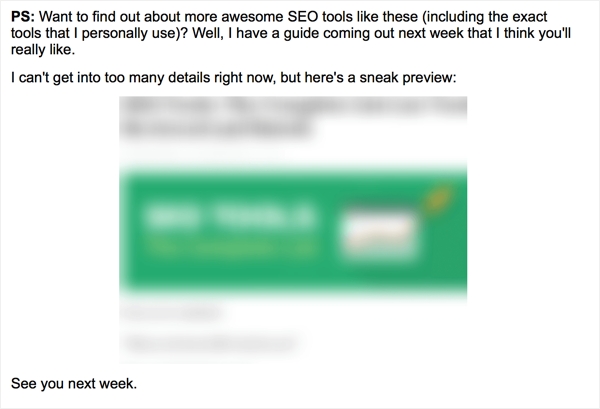
Prior to the blurry tease in his PS, Brian wrote 506 words of helpful content that most people would have considered a satisfying blog post in itself—and that’s exactly what makes his tease so effective.
Unless you’re Taylor Swift, your tease needs to be more than a simple, “Hey, watch out for my new thing next week.”
Instead, you should also do one of the following:
- Give your subscribers something of value, like Brian did with his helpful content.
- Ask them to do something, like giving you some feedback or answering a quick question.
Giving them one or both of these things will capture their attention much more effectively than a simple “heads up.”
#6: The “Unopened Resend” Email
If you’re like me, even your “best ever” email open rates are slightly depressing. When I see a 40% open rate, all I can think about is the 60% who didn’t open.
That’s why I absolutely love this email strategy from John Morgan, author of Brand Against the Machine and fellow blogger.
The premise is simple, yet the results it produces can have a major impact on the number of people who see your content. It boils down to this:
Resend the email announcing your latest blog post to all of your subscribers who didn’t open it the first time around.
You might think you’d risk annoying your subscribers by doing this but if you follow John’s method, the results I’ve seen say otherwise. Here’s how John does the resend to ensure little to no annoyance, in his own words:
I change the subject line, and sometimes the opening sentence, but the rest of the email is the same. This allows MUCH more traction for my content. For example, if 10,000 people opened one of my emails, but 20,000 did not, then I re-send to the 20,000 that did not open the first time and might get an additional 5,000 opens.
According to John, the results he’s getting have not only led to higher open and click rates but also to higher quality relationships with his audience:
My open rates and click-through rates overall have increased dramatically. As a result, I’m not having to create as much content. Gone are the days of churning out blog post after blog post just so I would have a reason to email my audience.
I’d heard of this strategy before but had been hesitant to try it with any of my clients’ email lists. In the end, John’s endorsement pushed me to test it.
Let’s just say I’m glad we gave it a shot. The results speak for themselves. Here are the statistics for the initial email:
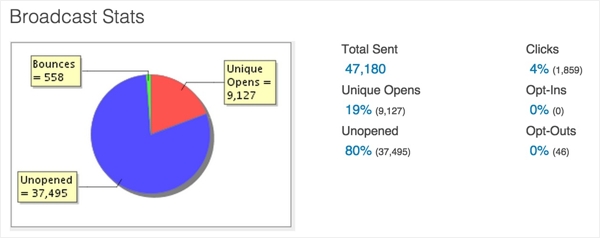
Five days later, we resent the email with a new subject line to the 37,495 people who didn’t open. Here’s the response:
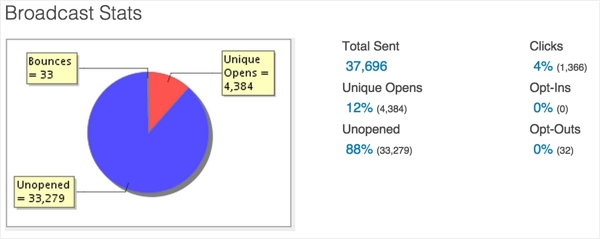
The second email added 4,384 more opens, bringing the cumulative open rate to 28.6%. It also brought in 1,366 more clicks, bringing the cumulative click rate to 6.8%.
Sure, there were additional opt-outs because of the second email, but the cumulative opt-out rate for both emails was still just a fraction of one percent at 0.16%.
You probably shouldn’t use this strategy for every single email you send out, but when you’re sending something of particular importance it’s an easy way to ensure a much larger percentage of your audience engages with it.
#7: The “How Can I Help You?” Email
Writing content that resonates with readers week after week, month after month, and year after year is a challenge for even the most experienced bloggers.
Even if you religiously keep notes and write down every idea and “aha” moment you can muster, at some point we all have felt like we’ve run out of good ideas.
Fortunately, there’s an easy solution: ask your audience how you can help them.
I know, I know. This seems a little weird. As content creators, shouldn’t we know what to give our audiences? Didn’t Steve Jobs say “people don’t know what they want until you show it to them”?
Well, while it’s true that people often don’t know exactly what they want, they do know the problems they’re struggling with. And if you frame your question in terms of problems, you’ll end up with more ideas than you ever imagined.
That’s the exact approach New York Times bestselling author (and online writing instructor) Jerry Jenkins took in a recent email to his blog subscribers. He opened with a subject line of “How can I best help you?” and went on to ask, “What would you most like me to write about?”
By itself, this would be a difficult question for many people to answer. But Jerry goes on to provide more helpful context:
Every writer struggles with something. I know I do.
Are you having trouble starting? Plotting? Crafting dialogue? Finishing strong? Something else?
There are so many topics, I could go for days. I’ve been in this game so long, my first blog was on how to keep your hieroglyphics chisel sharp.
So I’d love for you to clue me in on what would help you most today.
Jerry keeps the question open-ended but guides the reader’s thinking with topics and a final reminder that this is all about what they need help with.
The results? After an hour, there were already well over 100 responses from readers, many of them highly detailed and specific.
Look, if a guy who has written 21 New York Times bestsellers isn’t too prideful to ask his readers what he should write about, you shouldn’t be either. The ideas and insights you can gain are priceless.
Get Creative with Your Emails and Build Real Relationships
Experience shows that you can’t build lasting relationships just by doing the bare minimum.
But that’s exactly how you’re treating your subscribers if the only thing you email them is a stream of lazy “read this” reminders.
If you crave something deeper, if you want to have an actual, two-way relationship with the human beings behind those email addresses, it’s time for you to go a step beyond.
So do what it takes to make a connection with as many of them as possible.
Offer up your time for the chance to discover not only what they’re really struggling with, but who they are as people.
Ask questions and start conversations. Treat them like you would your closest friends.
Often, rekindling the flame (or sparking it in the first place) is as easy as sending one simple email.
Take that first step now. Pick the email that’s right for you and your readers, steal it, modify it, make it your own.
Then, all you have to do is press “Send.”
To view the original article Click Here

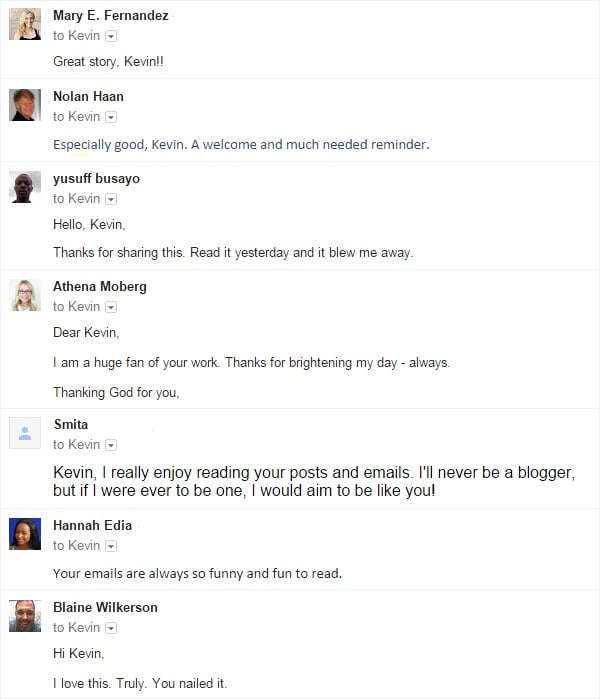
No comments:
Post a Comment